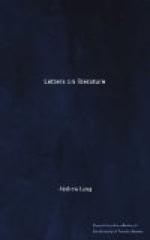My knowledge of Mr. William Morris’s poetry begins in years so far away that they seem like reminiscences of another existence. I remember sitting beneath Cardinal Beaton’s ruined castle at St. Andrews, looking across the bay to the sunset, while some one repeated “Two Red Roses across the Moon.” And I remember thinking that the poem was nonsense. With Mr. Morris’s other early verses, “The Defence of Guinevere,” this song of the moon and the roses was published in 1858. Probably the little book won no attention; it is not popular even now. Yet the lyrics remain in memories which forget all but a general impression of the vast “Earthly Paradise,” that huge decorative poem, in which slim maidens and green-clad men, and waters wan, and flowering apple trees, and rich palaces are all mingled as on some long ancient tapestry, shaken a little by the wind of death. They are not living and breathing people, these persons of the fables; they are but shadows, beautiful and faint, and their poem is fit reading for sleepy summer afternoons. But the characters in the lyrics in “The Defence of Guinevere” are people of flesh and blood, under their chain armour and their velvet, and the trappings of their tabards.
There is no book in the world quite like this of Mr. Morris’s old Oxford days when the spirit of the Middle Ages entered into him, with all its contradictions of faith and doubt, and its earnest desire to enjoy this life to the full in war and love, or to make certain of a future in which war is not, and all love is pure heavenly. If one were to choose favourites from “The Defence of Guinevere,” they would be the ballads of “Shameful Death,” and of “The Sailing of the Sword,” and “The Wind,” which has the wind’s wail in its voice, and all the mad regret of “Porphyria’s Lover” in its burden.
The use of “colour-words,” in all these pieces, is very curious and happy. The red ruby, the brown falcon, the white maids, “the scarlet roofs of the good town,” in “The Sailing of the Sword,” make the poem a vivid picture. Then look at the mad, remorseful sea-rover, the slayer of his lady, in “The Wind”:
“For my chair is heavy and
carved, and with sweeping green behind
It is hung, and the dragons thereon
grin out in the gusts of the wind;
On its folds an orange lies with
a deep gash cut in the rind;
If I move my chair it will scream,
and the orange will roll out far,
And the faint yellow juice ooze
out like blood from a wizard’s jar,
And the dogs will howl for those
who went last month the war.”
“The Blue Closet,” which is said to have been written for some drawings of Mr. Rossetti, is also a masterpiece in this romantic manner. Our brief English age of romanticism, our 1830, was 1856-60, when Mr. Morris, Mr. Burne Jones, and Mr. Swinburne were undergraduates. Perhaps it wants a peculiar turn of taste to admire these strange things, though “The Haystack in the Floods,” with its tragedy, must surely appeal to all who read poetry.




